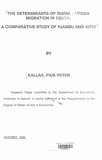| dc.description.abstract | The period after independence opened up economic opportunities for Kenyans
as they took over jobs formerly performed by expatriates.
Since most of the jobs and economic opportunities were concentrated in the
urban centres, there was acceleration in rural-urban migration. Such rapid influx of
people into towns created social problems in the provision of amenities and services
in education, health etc. At the same time, the movement took away able-bodied
people from rural communities.
Initially, the Government tackled the problem of job creation by the so-called
Tripartite agreements. These exacerbated rather than diminished rural-urban drift. With
the rapid expansion of education and dearth of economic opportunities in the rural
areas, the rate of growth of urban population has been in excess of the national
average, This paper investigated the determinants of rural-urban migration in two
districts of Kenya, one from a high potential area (Kiambu) the other from the Arid and
Semi-Arid Lands (ASAL) (Kitui). The study applying regression analysis focussed on
the influences of income differentials, education, amenities, distance of migrants to the
largest 40 towns with a population in excess of 10:QQQ...population. Data was based on
lifetime migrants (both male and female and by educational groups). Data on migrants
came from the 1989 Population Census while other economic variables were obtained
from the various issues of the Statistical Abstract, Economic Survey, Survey of rural
non-agricultural Enterprises etc. The econometric model was estimated using ordinary
least squares. Non-econometric analysis of tabulations was also done.
The results show the importance of the retarding effect of distance on migration,
and confirms the importance of "pull" of income differential between rural and urban
areas in Kenya. Education was also found to be an important accelerator of migration
Educated migrants were the least deterred by distance. On the regional question,
elasticities due to income differentials were of higher order for Kitui suggesting that
lowering income differentials in these ASAL areas would have a bigger impact than
for the more favoured districts.
Equalization of educational opportunities also are important in the redressing
regional inequalities. A close agreement between education and occupational class
was recorded. The study also confirmed the hypothesis that rural-urban migration
lowers fertility. | en |

